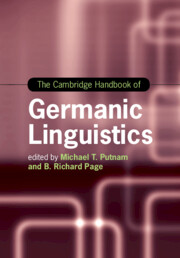Book contents
- The Cambridge Handbook of Germanic Linguistics
- Cambridge Handbooks in Language and Linguistics
- The Cambridge Handbook of Germanic Linguistics
- Copyright page
- Contents
- Figures
- Maps
- Tables
- Contributors
- Acknowledgments
- Germanic Languages
- Part I Phonology
- Part II Morphology and Agreement Systems
- Part III Syntax
- Chapter 15 VO-/OV-Base Ordering
- Chapter 16 The Placement of Finite Verbs
- Chapter 17 Germanic Infinitives
- Chapter 18 The Unification of Object Shift and Object Scrambling
- Chapter 19 Unbounded Dependency Constructions in Germanic
- Chapter 20 The Voice Domain in Germanic
- Chapter 21 Binding
- Chapter 22 Verbal Particles, Results, and Directed Motion
- Chapter 23 Structure of Noun (NP) and Determiner Phrases (DP)
- Part IV Semantics and Pragmatics
- Part V Language Contact and Nonstandard Varieties
- Index
- References
Chapter 15 - VO-/OV-Base Ordering
from Part III - Syntax
Published online by Cambridge University Press: 31 March 2020
- The Cambridge Handbook of Germanic Linguistics
- Cambridge Handbooks in Language and Linguistics
- The Cambridge Handbook of Germanic Linguistics
- Copyright page
- Contents
- Figures
- Maps
- Tables
- Contributors
- Acknowledgments
- Germanic Languages
- Part I Phonology
- Part II Morphology and Agreement Systems
- Part III Syntax
- Chapter 15 VO-/OV-Base Ordering
- Chapter 16 The Placement of Finite Verbs
- Chapter 17 Germanic Infinitives
- Chapter 18 The Unification of Object Shift and Object Scrambling
- Chapter 19 Unbounded Dependency Constructions in Germanic
- Chapter 20 The Voice Domain in Germanic
- Chapter 21 Binding
- Chapter 22 Verbal Particles, Results, and Directed Motion
- Chapter 23 Structure of Noun (NP) and Determiner Phrases (DP)
- Part IV Semantics and Pragmatics
- Part V Language Contact and Nonstandard Varieties
- Index
- References
Summary
In North-Germanic languages and English, VPs are head-initial. In continental West-Germanic languages, VPs are head-final. This chapter surveys major syntactic contrasts that directly correlate with this structural difference. Head-initial phrases are structurally more tightly constrained than head-final phrases. Since clauses typically contain VPs, constraints on VPs are reflected in the clause structure. Syntactic differences triggered by head-positioning show in contrasts such as the following. Head-initial VPs are strictly ordered, that is, the relative order of arguments does not change; adjuncts do not intervene between the head and the arguments; the relative order of auxiliaries is invariable. In addition to the VP-internal contrasts, there are VP-external ones, too. Adjuncts preceding head-initial phrases are head-adjacent, hence adjuncts preceding head-initial VPs are minimized. Finally, head-initial VPs with a preverbal subject entail clause structures with an obligatory subject position. All these restrictions are absent when the VP is head-final.
- Type
- Chapter
- Information
- The Cambridge Handbook of Germanic Linguistics , pp. 339 - 364Publisher: Cambridge University PressPrint publication year: 2020
References
- 2
- Cited by



